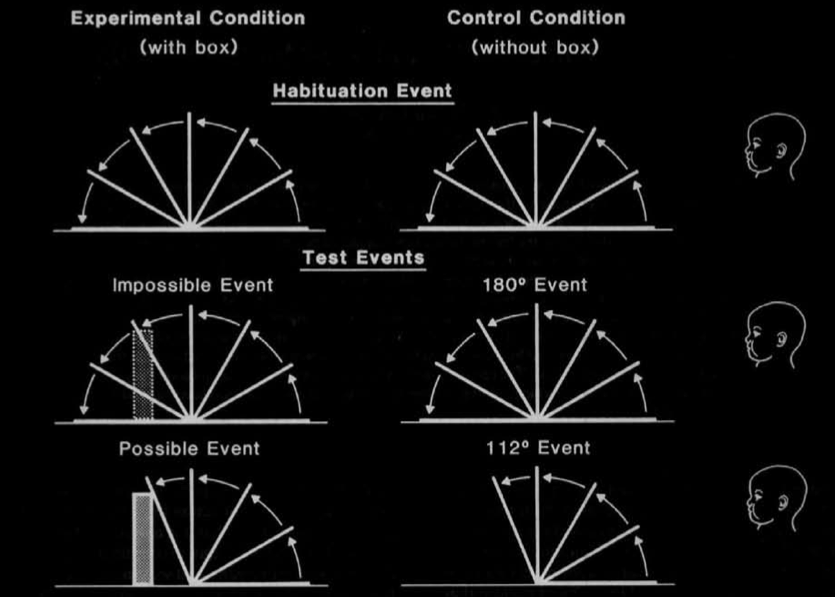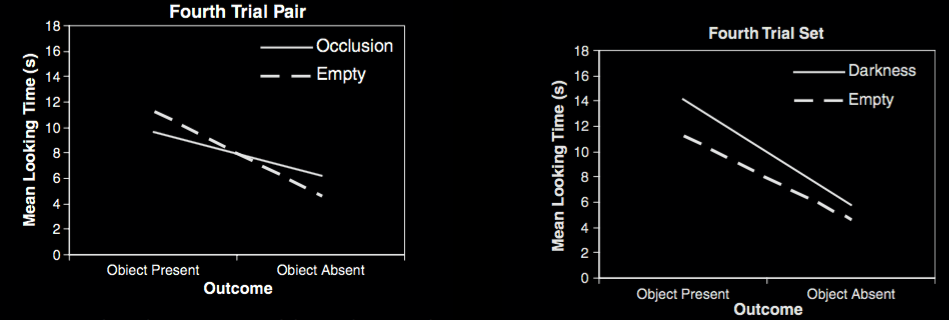Click here and press the right key for the next slide.
(This may not work on mobile or ipad. You can try using chrome or firefox, but even that may fail. Sorry.)
also ...
Press the left key to go backwards (or swipe right)
Press n to toggle whether notes are shown (or add '?notes' to the url before the #)
Press m or double tap to slide thumbnails (menu)
Press ? at any time to show the keyboard shortcuts
Against the Simple View

Against the Simple View
[email protected]
Three Questions
1. How do four-month-old infants model physical objects?
2. What is the relation between the model and the infants?
3. What is the relation between the model and the things modelled (physical objects)?
the Simple View
conflicting evidence: permanence

Baillargeon et al 1987, figure 1

Shinskey and Munakata 2001, figure 1

Shinskey and Munakata 2001, figure 2
Responses to the occlusion of a desirable object
- look (from 2.5 months)
(Aguiar & Baillargeon 1999, Experiment 2)
- reach (7--9 months)
(Shinskey & Munakata 2001)
‘action demands are not the only cause of failures on occlusion tasks’
Shinskey (2012, p. 291)
conflicting evidence: causal interactions

Spelke et al 1992, figure 2





search

Hood et al 2003, figure 4



The Simple View
generates
multiple
incorrect predictions.
‘A similar permanent dissociation in understanding object support relations might exist in chimpanzees. They identify impossible support relations in looking tasks, but fail to do so in active problem solving.’
(Gomez 2005)
Likewise for cotton-top tamarins (Santos et al 2006) and marmosets (Cacchione et al 2012).
‘to date, adult primates’ failures on search tasks appear to exactly mirror the cases in which human toddlers perform poorly.’
(Santos & Hood 2009, p. 17)
What about the chicks and dogs?
generality of the problem
| domain | evidence for knowledge in infancy | evidence against knowledge |
| colour | categories used in learning labels & functions | failure to use colour as a dimension in ‘same as’ judgements |
| physical objects | patterns of dishabituation and anticipatory looking | unreflected in planned action (may influence online control) |
| number | --""-- | --""-- |
| syntax | anticipatory looking | [as adults] |
| minds | reflected in anticipatory looking, communication, &c | not reflected in judgements about action, desire, ... |
The Simple View
generates
multiple
incorrect predictions.
| occlusion | endarkening | |
| violation-of-expectations | ✔ | ✘ |
| manual search | ✘ | ✔ |
Charles & Rivera (2009)

Charles & Rivera, figure 1 (part)

Charles & Rivera, 2009 fig 3a-c



Charles & Rivera, 2009 figs 5-6
| occlusion | endarkening | |
| violation-of-expectations | ✔ | ✘ |
| manual search | ✘ | ✔ |
Charles & Rivera (2009)
The Simple View
generates
multiple
incorrect predictions.
Three Questions
1. How do four-month-old infants model physical objects?
2. What is the relation between the model and the infants?
3. What is the relation between the model and the things modelled (physical objects)?
Four-month-olds can act (e.g. look, and reach) for the reason that this object is there.
Four-month-olds cannot believe, nor know, that this object is there.
Crude Picture of the Mind
- epistemic
(knowledge states) - broadly motoric
(motor representations of outcomes and affordances) - broadly perceptual
(visual, tactual, ... representations; object indexes ...)

‘if you want to describe what is going on in the head of the child when it has a few words which it utters in appropriate situations, you will fail for lack of the right sort of words of your own.
‘We have many vocabularies for describing nature when we regard it as mindless, and we have a mentalistic vocabulary for describing thought and intentional action; what we lack is a way of describing what is in between’
(Davidson 1999, p. 11)